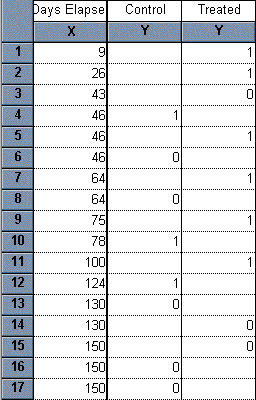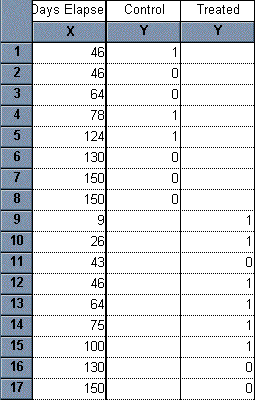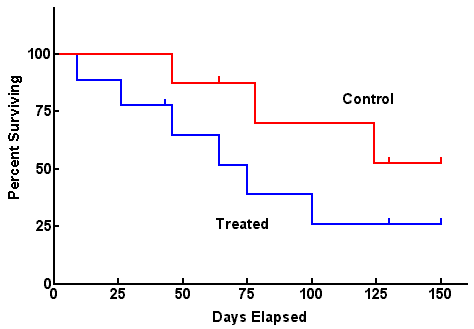Prism 3 -- Kaplan Meier Survival Analysis
Step-by-Step Examples:
Kaplan Meier Survival Analysis using Prism 3
With some experiments, the outcome is a survival time, and you want to compare the survival of two or more groups. Survival curves show, for each plotted time on the X axis, the portion of all individuals surviving as of that time. The term "survival" is a bit misleading; you can use survival curves to study times required to reach any well-defined end point (e.g., re-occlusion of a grafted blood vessel, first metastasis, discharge from the hospital).
Prism creates survival curves using the method of Kaplan and Meier and calculates the 95% confidence interval for fractional survival at any particular time. Prism can also compare two or more survival curves using the log-rank test.
To create a survival curve using Prism, follow these steps:
Enter the Data
In the Welcome to Prism dialog box, select Create a new project and Work independently. Under the X Column category, select Numbers, and under the Y Columns category, select A single column of values. You can compare several treatments, but within each treatment group, outcomes will be recorded in a single column-there are no replicates.
For each subject in the study, enter into the X column the time elapsed (e.g., days, months) between entry of the subject into the study and the time of the "outcome" event for that subject. This is the survival time for that subject. In the Y column, enter the code "1" to denote occurrence of your designated experimental outcome, or the code "0" to denote that the subject was censored, opposite the corresponding elapsed time (X-column entry).
A subject is censored when you have no useful information about what happened to the subject after that time. Subjects alive at the end of the study are censored, because you do not know about their later survival. Subjects who leave the study are also censored - either because you do not know whether or not they survived, or because you can't use that information because they were no longer following the study protocol.
If you have more than one event for a particular time, simply enter multiple rows with the same X value.
 |
Example Data Table
For this example transplant study, we'll describe just the Control data in column A. Subjects in the Control group died (code = 1) at 46, 78, and 124 days after transplant. One subject in the Control group was lost to follow-up (code = 0) 46 days after treatment, and another was dropped for noncompliance (code = 0) 64 days after treatment. At the end of the study, three subjects were still alive and enrolled in the study; one had survived for 130 days, and the other for 150 days, after treatment.
You don't have to enter X values in order of occurrence. In fact, if it is more convenient, you can enter all of your data for a particular treatment group together, as shown below. Just be sure to match each event code (Y-column entry) to its proper time (X-column entry).
 |
Data Vertically Ordered by Group
All the data for the Control group are entered first (rows 1-8), followed by the data for the Treated group.
Before proceeding, make sure that each subject in your study is represented exactly once (by either 1 or 0) in the Y data column. In other words, the total number of 1's and 0's entered in each column should equal the number of subjects in that group.
For more information about entering survival data, consult How survival analyses work.
Analyze the Data
Click the Analyze button. Choose Built-in analysis. From the Statistical Analyses category, select Survival curve.
In the Parameters: Survival curve dialog box, accept the default coding. Although you can redefine the codes (use digits, not letters), 1 is ordinarily the code for death (or similar endpoint, while 0 indicates a censored subject). In the Output portion of the box, select Percents starting at 100%, so that Prism will express your data as the percentage, rather than a fraction, of all individuals, and it will display the decreasing survival as a downward-sloping curve. Choose Show censored subjects on graph, so that each censored subject will appear as a data point on a flat part of the curve.
View the Results
You can see the results on three pages, which you can access from the "View" drop-down box: Survival proportions, showing fractional survival at each plotted time; # of subjects at risk, number of subjects still alive up until each time point; and Curve comparison, using the logrank test.
 |
Complete the Graph
Click on the Graphs folder tab to view the graph automatically created by Prism (a standard XY plot with error bars). To change this graph to a survival curve, double click on one of the data points to open the Format Symbols and Lines dialog box. Holding down the control key (so that the changes affect both data sets), check the Connecting line box, and change the style to Staircase. Remove the checkmark from the Error bars box. Change the symbol shape to upticks (the fifth choice from the bottom), and change the symbol size to 8 and the thickness to 3 pt.
 |















